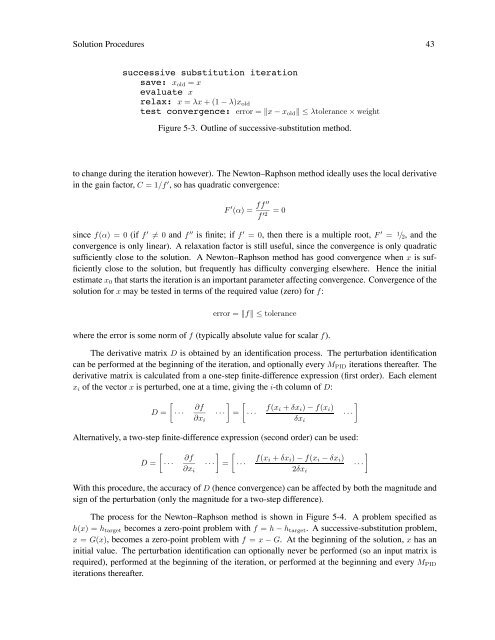Download - NASA
Download - NASA
Download - NASA
Create successful ePaper yourself
Turn your PDF publications into a flip-book with our unique Google optimized e-Paper software.
Solution Procedures 43<br />
successive substitution iteration<br />
save: xold = x<br />
evaluate x<br />
relax: x = λx +(1− λ)xold<br />
test convergence: error = x − xold ≤λtolerance × weight<br />
Figure 5-3. Outline of successive-substitution method.<br />
to change during the iteration however). The Newton–Raphson method ideally uses the local derivative<br />
in the gain factor, C =1/f ′ , so has quadratic convergence:<br />
F ′ (α) = ff′′<br />
=0<br />
f ′2<br />
since f(α) =0(if f ′ = 0and f ′′ is finite; if f ′ =0, then there is a multiple root, F ′ = 1/2, and the<br />
convergence is only linear). A relaxation factor is still useful, since the convergence is only quadratic<br />
sufficiently close to the solution. A Newton–Raphson method has good convergence when x is sufficiently<br />
close to the solution, but frequently has difficulty converging elsewhere. Hence the initial<br />
estimate x0 that starts the iteration is an important parameter affecting convergence. Convergence of the<br />
solution for x may be tested in terms of the required value (zero) for f:<br />
error = f ≤tolerance<br />
where the error is some norm of f (typically absolute value for scalar f).<br />
The derivative matrix D is obtained by an identification process. The perturbation identification<br />
can be performed at the beginning of the iteration, and optionally every MPID iterations thereafter. The<br />
derivative matrix is calculated from a one-step finite-difference expression (first order). Each element<br />
xi of the vector x is perturbed, one at a time, giving the i-th column of D:<br />
D =<br />
<br />
···<br />
∂f<br />
∂xi<br />
<br />
··· = ···<br />
f(xi + δxi) − f(xi)<br />
Alternatively, a two-step finite-difference expression (second order) can be used:<br />
D =<br />
<br />
···<br />
∂f<br />
∂xi<br />
<br />
··· = ···<br />
δxi<br />
f(xi + δxi) − f(xi − δxi)<br />
With this procedure, the accuracy of D (hence convergence) can be affected by both the magnitude and<br />
sign of the perturbation (only the magnitude for a two-step difference).<br />
The process for the Newton–Raphson method is shown in Figure 5-4. A problem specified as<br />
h(x) =htarget becomes a zero-point problem with f = h − htarget. A successive-substitution problem,<br />
x = G(x), becomes a zero-point problem with f = x − G. At the beginning of the solution, x has an<br />
initial value. The perturbation identification can optionally never be performed (so an input matrix is<br />
required), performed at the beginning of the iteration, or performed at the beginning and every MPID<br />
iterations thereafter.<br />
2δxi<br />
···<br />
<br />
···
















